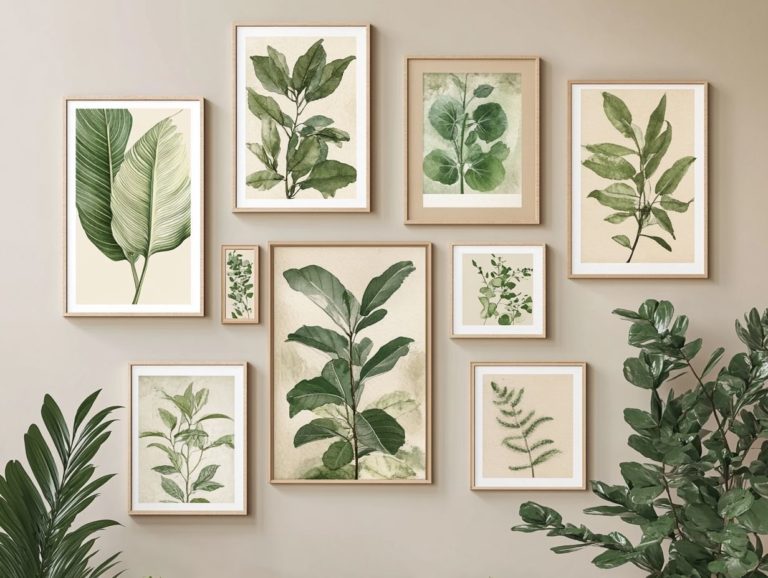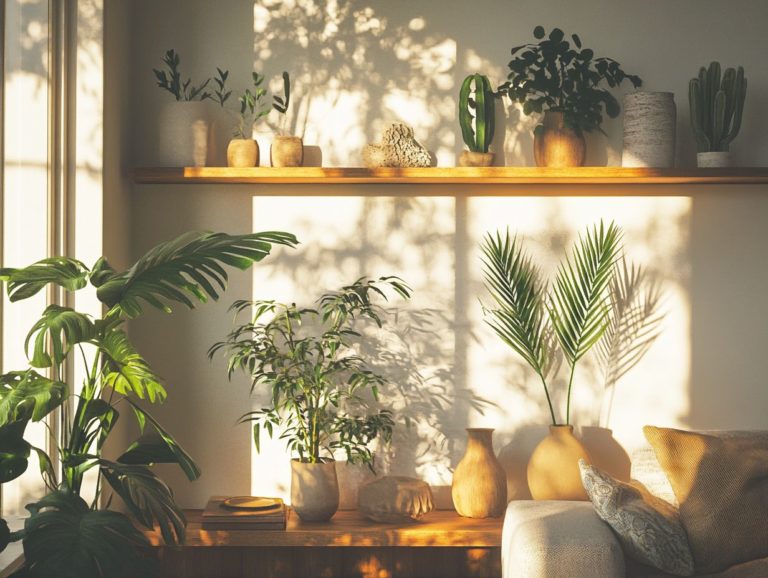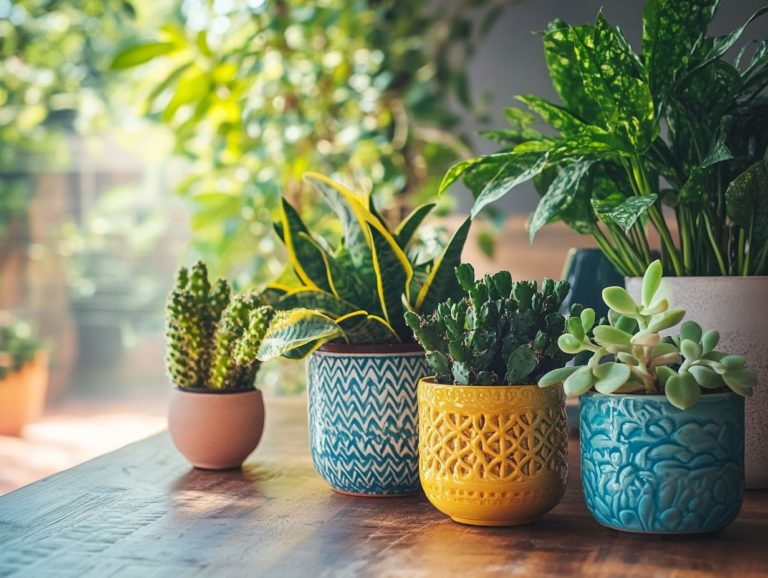Choosing the Right Planters for Indoor Plants
Indoor plants are a game-changer for your home! They not only add decorative beauty but also improve air quality and lift your mood.
Choosing the right planter is important for your plants’ well-being. With various materials, sizes, and styles available, understanding the specific needs of your greenery and matching them with suitable planters can significantly affect their growth and vitality.
This article explores the benefits of indoor plants, provides expert advice on selecting the ideal planter, and shares essential maintenance tips to help your indoor sanctuary thrive.
Contents
- Key Takeaways:
- Benefits of Indoor Plants
- Factors to Consider When Choosing Planters
- Types of Planters
- Choosing the Right Planter for Your Plant
- Maintenance and Care for Indoor Planters
- Frequently Asked Questions
- 1) What factors should I consider when choosing the right planters for my indoor plants?
- 2) How do I determine the appropriate size of planter for my indoor plants?
- 3) Can I use any type of planter for my indoor plants?
- 4) What materials are best for indoor planters?
- 5) How do I ensure proper drainage for my indoor planters?
- 6) Do I need to repot my indoor plants often?
Key Takeaways:
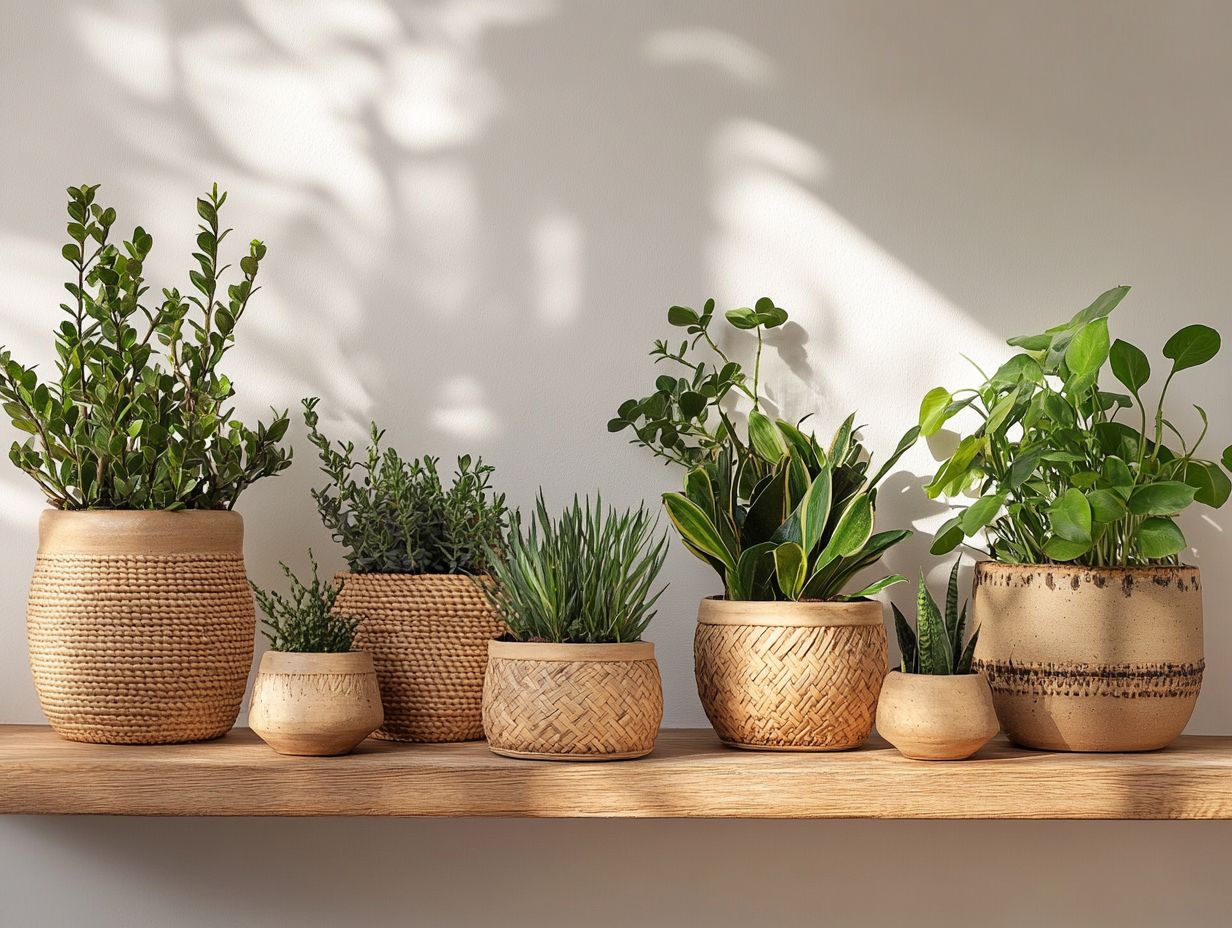
- Indoor plants enhance your space’s aesthetic value and improve air quality and mood.
- When choosing planters, consider size, drainage holes, pot size, and aesthetics.
- Match plant needs with planter features for healthy growth and easy maintenance.
Benefits of Indoor Plants
Indoor plants are essential for gardening enthusiasts and plant parents alike. They provide exceptional benefits that improve air quality and uplift mood while transforming your living space into a serene sanctuary.
Bringing houseplants into your indoor environment can purify the air and create a natural ambiance that promotes well-being. Research indicates that greenery positively impacts both physical health and emotional states, making plants a vital addition to any home.
As you explore horticulture, recognizing native plants that thrive indoors will enhance your experience and strengthen your connection to nature.
How Indoor Plants Improve Air Quality and Mood
Indoor plants significantly enhance air quality by filtering out toxins. Their vibrant presence purifies the air and uplifts your mood, making them perfect for any indoor gardening enthusiast.
Scientific studies highlight the remarkable abilities of certain houseplants to remove harmful pollutants like formaldehyde and benzene from the air. Varieties such as spider plants, peace lilies, and snake plants are renowned for their superior purifying properties.
The benefits go beyond cleaner air; greenery in your living space fosters tranquility and well-being. This connection to nature elevates the ambiance, making your environment feel serene and inviting.
Incorporating plants into your home contributes to a healthier lifestyle and supports improved mental health, ensuring that your plant babies flourish.
Factors to Consider When Choosing Planters
Selecting the right planter is crucial for your houseplants’ well-being. Consider factors such as pot size, drainage holes, and the type of container, including decorative outer containers, to give your plants the proper care they deserve.
The right container impacts the roots and their growth potential. Paying attention to size and volume can help you avoid issues like overwatering.
Choosing a decorative outer container, like a cachepot, not only supports your plants but also enhances the aesthetics of your indoor gardening space, making it an essential aspect of plant maintenance.
Size and Drainage Needs
Understanding your houseplants’ size and drainage needs is essential. Selecting the right pot size with adequate drainage holes can greatly influence plant health and help prevent root rot.
When selecting a pot, consider how its dimensions affect the root system. A larger container provides ample room for root expansion, while a smaller pot can restrict roots, stunting their growth. Proper drainage holes are vital, allowing excess water to escape and preventing waterlogging, a leading cause of root rot.
If a plant thrives in well-draining soil but is placed in an overly large pot, excess moisture can lead to overwatering. Keep an eye on the container’s size and adjust it according to the plant’s growth stage, ensuring the roots have enough space while safeguarding their health.
Ready to elevate your indoor gardening experience? Start selecting your planters today and transform your space into a vibrant oasis!
Material and Aesthetic Preferences

When selecting planters, the material and aesthetic choices such as ceramic pots, plastic pots, and metal containers are crucial for complementing your indoor gardening style while ensuring durability and the health of your plants.
Choosing the perfect pot can transform your indoor garden! Each pot material not only impacts the visual appeal of your indoor space but also affects the well-being of your plants. For instance, ceramic pots offer a charming aesthetic and are good at keeping the temperature stable, making them ideal for temperature-sensitive plants. Additionally, understanding choosing the right potting mix for your plants is essential for their growth and health.
In contrast, plastic pots are lightweight and versatile, although they may lack the breathability found in other materials. Metal containers provide style; however, they can heat up quickly, which might affect root health. Fiberglass pots combine durability with modern aesthetics, making them both practical and visually appealing.
Concrete planters are incredibly sturdy and provide excellent thermal regulation, but their weight requires careful placement. Each of these materials has unique characteristics that can either enhance or hinder the growth of your indoor plants, making your selection process all the more important.
Types of Planters
Explore the diverse types of planters available. Your houseplants deserve the best, and the right choice can elevate your space!
From classic terra cotta and elegant ceramic to practical plastic and charming wooden options, the choices are abundant. To ensure the best growth for your plants, consider how to choose soil for her indoor garden. Don’t overlook the innovative hanging planters that can beautifully maximize your space while showcasing your greenery.
Terra Cotta
Terra cotta planters are an exceptional choice for discerning plant enthusiasts like you. They feature outstanding drainage capabilities and a breathable material, making them perfect for a wide range of houseplants.
This unique composition allows excess water to evaporate, effectively preventing root rot and fostering healthy growth. The porous nature of terra cotta also promotes essential air exchange, ensuring that roots breathe easily. By maintaining a balanced moisture level, these pots create an ideal environment for your plants.
For optimal results, consider pairing these planters with a high-quality potting mix that features:
- Organic matter like peat moss
- Coconut coir
- Perlite for added aeration
These combinations enhance drainage and moisture retention, creating a balanced moisture level essential for plant health.
Ceramic
Ceramic pots not only elevate the aesthetic of your space but also stand the test of time. They are a top choice for indoor gardening enthusiasts wishing to enhance their living environments.
These versatile containers come in an array of designs, colors, and sizes, allowing you to showcase your unique style while providing the perfect backdrop for your cherished houseplants. The insulation properties of ceramic help maintain a stable soil temperature, promoting healthier root growth and reducing the need for constant watering.
Ceramic pots also serve as elegant decorative elements that complement various interior styles, adding sophistication to any room. With options ranging from rustic to modern finishes, these pots blend effortlessly into your d cor, transforming them from mere functional items into striking focal points.
Ready to discover how these pots can enhance your space?
Plastic
Plastic pots offer you a versatile and budget-friendly option for your houseplants. They provide lightweight solutions that make it easy to move and rearrange your plants.
They appeal to both beginners and seasoned gardeners alike, thanks to their practicality. This makes them perfect for a range of plants from tiny succulents to larger indoor specimens.
In outdoor settings, these pots can endure various weather conditions. However, it’s wise to consider their durability over time, especially when faced with harsh elements.
While generally more cost-effective than ceramic or metal options, there are some downsides to consider. These include limited breathability and the potential for UV degradation if they are left in direct sunlight for too long.
Ultimately, your choice to use plastic pots will come down to finding the right balance between convenience and the long-term health of your cherished plants, including selecting the best potting mixes for small indoor plants.
Wooden

Imagine transforming your space with these stunning wooden planters! They offer a natural look and aesthetic appeal, making them a delightful choice for anyone looking to infuse rustic charm into their indoor gardening.
These enchanting planters not only elevate the visual allure of any room but also benefit your plants health. Their ability to hold moisture facilitates better air circulation, creating an optimal environment for roots to thrive.
To ensure your wooden planters stand the test of time, select rot-resistant wood types and consider applying a natural, non-toxic sealant to guard against moisture damage.
By keeping up with regular maintenance checking for wear or mold you can ensure that these stunning planters continue to foster healthy plant growth. They re truly a smart investment for any plant enthusiast.
Hanging
Hanging planters present an innovative solution for maximizing space. They allow you to showcase your beloved houseplants while adding a decorative flair to your indoor gardening sanctuary.
These unique planters elevate the aesthetic appeal of any room and free up valuable surface area. This makes them perfect for small apartments or studios.
By utilizing vertical space, they create the illusion of a larger area while cultivating a lush, inviting atmosphere. Hanging planters come in various styles, colors, and materials, offering you endless opportunities for creativity.
When selecting plants for these arrangements, consider options like trailing ivy, ferns, and pothos. These choices drape gracefully over the edges, enhancing both the greenery and visual interest in your space.
Choosing the Right Planter for Your Plant
Selecting the perfect pot for your houseplants requires a keen understanding of their unique needs. It also involves aligning those needs with the ideal features of a planter.
By doing so, you can ensure that your plants receive the utmost care and thrive in a healthy environment.
Matching Plant Needs with Planter Features
Matching your plants needs with the right planter features is essential for ensuring their thriving health. Size truly matters, and the choice of pot materials can impact their growth.
The ideal planter provides ample room for root expansion and facilitates proper drainage and moisture retention both key for the well-being of various plants.
For example, larger plants with extensive root systems thrive in spacious pots made from breathable materials like terracotta, which help prevent root rot. On the other hand, smaller houseplants or succulents flourish in tighter, more compact spaces that create a nurturing environment.
Choosing containers with built-in drainage holes is essential for plant care. Drainage holes help excess water escape, preventing root rot and ensuring proper air circulation key elements for fostering robust growth.
By paying attention to these details, you set the stage for a flourishing green sanctuary.
Maintenance and Care for Indoor Planters
Ensuring proper maintenance and care for your indoor planters is crucial for promoting the health and longevity of your houseplants. This includes paying close attention to details like watering schedules and keeping the pots clean.
Your plants will thrive when you invest this kind of mindful care. Take charge of your plant care today!
Key Takeaways: Choosing the right planter involves understanding your plants’ needs and matching them with appropriate features. Additionally, choosing the right water for indoor plants is crucial. Regular maintenance and proper care will ensure your indoor garden flourishes.
Essential Tips to Keep Your Plants Thriving!
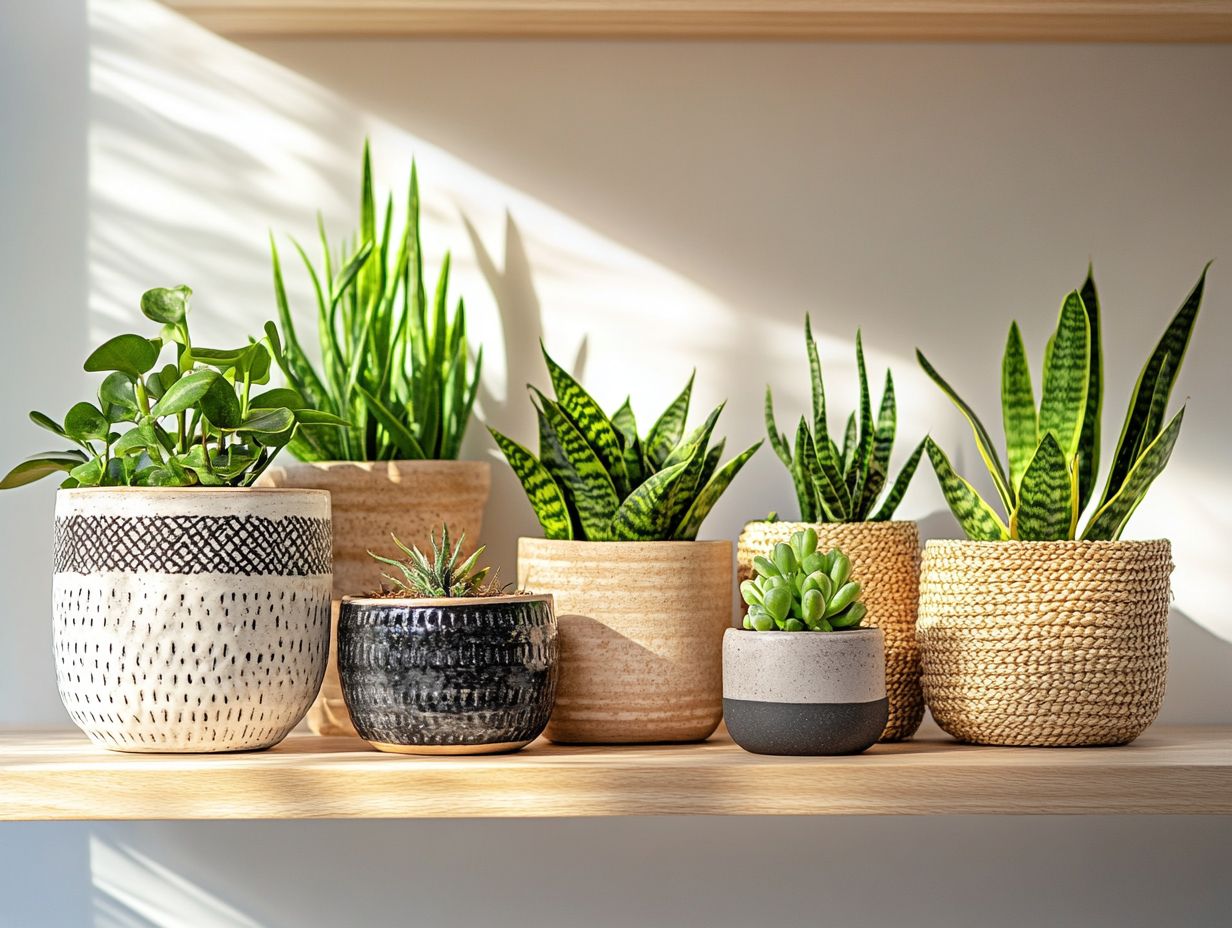
Let s keep your planters and plants thriving! With a few simple tips, you can make sure they stay vibrant and healthy.
Your watering schedule is crucial. It ensures your plants get the right amount of water to thrive avoiding the extremes of being waterlogged or dry.
Selecting a premium potting mix can dramatically influence their growth. It offers essential nutrients, promotes proper drainage, and allows air to reach the roots.
Cleaning your pots is essential. A quick scrub with mild soap can create a healthier environment for your leafy friends!
Frequently Asked Questions
1) What factors should I consider when choosing the right planters for my indoor plants?
When choosing planters for indoor plants, consider the size and shape of the pot, drainage holes, material, and overall aesthetic. These factors can affect the health and growth of your plants.
2) How do I determine the appropriate size of planter for my indoor plants?
A good rule is to choose a pot that is 1-2 inches larger in diameter than your plant’s current pot. This allows enough room for growth without the risk of over-watering.
3) Can I use any type of planter for my indoor plants?
While there are many options for indoor planters, it s important to select one with drainage holes to prevent water accumulation and root rot. Some plants require specific pots, like clay for those that need well-draining soil.
4) What materials are best for indoor planters?
You can choose from various materials, including clay, ceramic, plastic, or fabric. It s essential to consider your plant’s needs and its environment. For example, if your plant requires good drainage, clay or ceramic may be the best option.
5) How do I ensure proper drainage for my indoor planters?
If your planter lacks drainage holes, you can create them yourself using a drill. Alternatively, place a layer of gravel or rocks at the bottom of the pot before adding soil to help with drainage.
6) Do I need to repot my indoor plants often?
It s recommended to repot your indoor plants every 1-2 years, depending on their growth and root system. This allows for fresh soil and room for growth. If you notice your plant becoming root-bound or showing signs of stunted growth, it may be time to repot.



